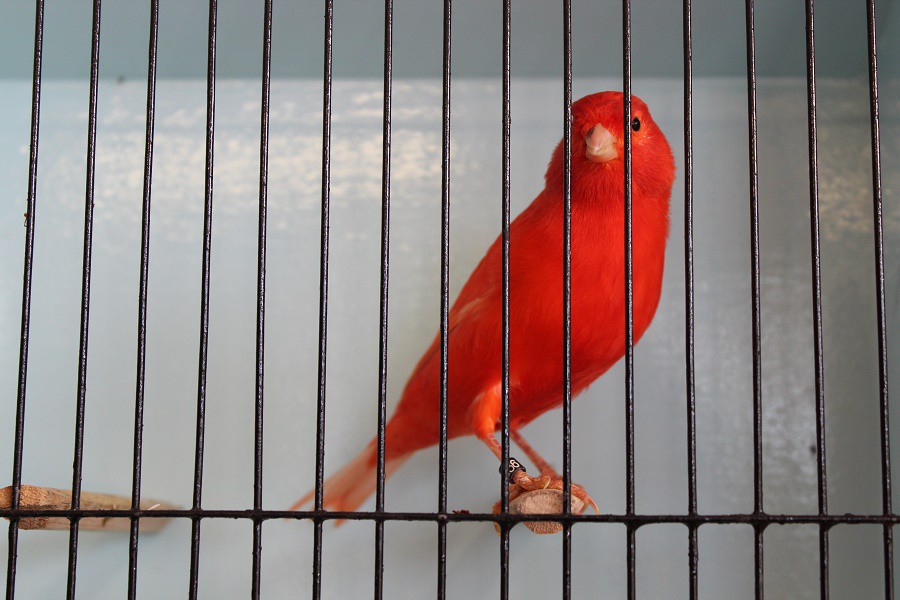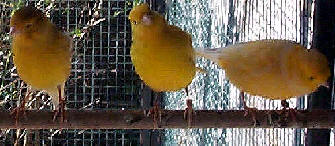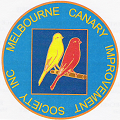
CARE OF YOUR PET CANARY
 Caution : You should consider carefully before buying a pet bird. A whistling canary is easy to care for and will give you years of pleasure if looked after properly. However, he is doomed to a short miserable life if you do not attend to his basic needs. Remember he is totally reliant on you for all his requirements.
Caution : You should consider carefully before buying a pet bird. A whistling canary is easy to care for and will give you years of pleasure if looked after properly. However, he is doomed to a short miserable life if you do not attend to his basic needs. Remember he is totally reliant on you for all his requirements.
SELECTION OF A BIRD. It is only the male that sings.
You might have already set your mind on one particular colour canary, but colour should not come before song. The best and strongest of all is the green bird, but too often these are overlooked for some other colour. Usually the popular colour is yellow. It must be pointed out here that the colour of the original canary is green, maybe not as nice as a green as we see in most canaries today, but never the less green. Yellow canaries came after the greens. Today canaries may be purchased in fawn, cinnamon, white, blue and various shades of red.
The age of the bird you intend buying is another important consideration, naturally the younger the bird, the longer you are likely to keep him.
All canary exhibitors, and may fanciers who do not show their canaries, belong to a Canary Club. Club member’s purchase closed metal rings, which are placed on the birds legs when they are about ten days old. These rings are stamped with the initials of the club from which they were issued along with the year and the registered numbers. Each year the colour of the rings is changed and most canary fanciers can tell the age of a bird by the colour of the club ring it has on its leg.
When selecting a pet canary choose a young healthy bird which is bright, alert and bouncy, not one that sits perched with ruffled up feathers. Birds may be purchased from pet shops or dealers, however quality guaranteed canaries are also available from our club members. Any Email enquiry’s will be directed to an appropriate breeder.
VARIETIES OF CANARIES : The ability of the male canary to sing or whistle varies from one bird to another and has very little to do with its variety. There are several varieties of canaries such as Norwich, Lizards, Border Fancy, Glosters, Yorkshires, Australian Plain Head, Crested Norwich, New Mutations, the many shades of Red Factors, and the German Rollers.
All of the above breeds of canary, with the exception of the German Roller, sing with their mouths or beaks wide open. The little German Roller sings with his beak closed. He has a very soft song and is classed as outstanding in his ability to produce different notes and tones. The German Roller is not for the hard of hearing.
THE CAGE : The cage should be one suited to the canary and not chosen for its decorative appeal. Unlike budgies canaries haven’t the capacity for endless amusement with toy’s, so they should be housed in roomy and well sited cage to allow exercise and alleviate boredom. Perches should be well spaced and placed at different heights if possible. They should be of soft wood, round of 12 to 16mm diameter or square with the corners rounded off and of different sizes so the birds feet are not always in the same position. Place seed and water containers where they will not be fouled by the birds droppings.
SITING THE CAGE : Canaries must be kept in fresh atmosphere as they are particularly sensitive to foul or polluted air. Inside, you must select a site well away from any gas appliances. The cage must not hang in draught for fear the bird will catch a chill. Direct sunlight is yet another thing to be avoided, especially in the summer. While canaries love sunlight they do not appreciate being left in direct or in a room which is too hot. High temperatures could quite easily force your bird in to a false moult in order to maintain an even body temperature, your bird will then shed some of his feathers and will more than likely stop singing. Located outside under the eaves and against the wall could prove to be a suitable place, but only after you have made sure the bird will be safe from stray cats, wild birds and inclement weather. Stray cats can, and often do cause death to caged canaries, also wild birds are quite capable of removing a pet canary without leaving a trace of their visit. Unless your cage is situated in an easterly or north-easterly direction the weather can easily bring harm. If your bird is to be permanently kept outside, a wooden box type cage is most suitable. Consideration might also be given to providing a double grill arrangement, that is an extra grill or front, mounted approximately 50mm in front of the primary grill to prevent intruders from reaching into the cage.
CLEANLINESS : Keep the cage spotlessly clean at all times. Wash the food and drink utensils regularly, disinfect the cage at least three times a year and take special care to clean the perches. Perches should never be washed unless there is another set to take their place. Wet perches cause canaries discomfort. If you have just one set of perches it would be far wiser to take them out and scrape them clean with a sharp knife or similar implement. You may sand paper the perches but be sure they are not left too smooth , as the smoother the perches the harder the bird has to grip to keep his balance. The drinking tube is most effectively cleaned using a small bottle brush. Use brown or clear white paper to cover the floor of the cage. Don’t use newspaper as it can be most harmful, as there is a risk of the print coming off. When this happens the ink tends to take the moisture out of the birds toes and legs.
THE BIRDS NEEDS :
SEED : The type of seed you supply to your bird is of the utmost importance. Buy a good fresh seed mix from a pet shop or merchant. A good seed mix will help provide a balanced diet. Blow of the husks daily and change the seed in the dish regularly.
SHELL GRIT : A canary has no teeth to grind its food and it needs grit present in its gizzard to do the grinding for it. Birds must not be given shell grit that is wet.
MINERALS & VITAMINS : These are lacking in most seeds and should be supplied by means of cuttle fish bone, a small amount of common salt mixed in the seed and especially green food – silver beet leaves, endive, thistles etc. Cucumber or zucchini can be fed during the moult ( January – March ). A peice of apple or orange will always be appreciated.
FRESH WATER : Must be available at all times. The plastic ‘tube’ feeder is very convenient but must be kept clean at all times. Give your bird a separate suitable dish containing water for a bath about three times a week. You be amazed how much he enjoys this.
COLOUR FEEDING : To keep red colour the bird will have to be “colour fed” through out the moult. Colour feed can be bought at pet shops or through the Club and is added to the drinking water.
THE ANNUAL MOULT : Once a year your pet canary will, under normal conditions, shed all its feathers for a complete new set. He will commence his moult sometime during the late Summer or early Autumn, and will usually take as many as ten weeks to complete the change. During the time the moult is taking place the bird might cease to sing. The annual moult is a natural thing for a bird, but there are several ways you can assist him through this period.
You must keep him out of the sunlight as much as possible, cover him up at night much earlier than you normally would and allow him to get as much rest through the day as he needs by not disturbing him unnecessarily. Feed him oily seeds such as sunflower, rape and linseed. Give him the opportunity to bathe more often. If you look after him during the moult you will be well rewarded when he again begins to whistle complete with his new set of feathers.
FURTHERING YOUR INTEREST : There is a great deal of enjoyment to be had from breeding and showing canaries. If you feel you might like to make a hobby of bird keeping and you are able to attend, come along obligation free, to one of our meetings, help and advice is readily available.
Note: The information given here is relative to the location of Australia in the Southern Hemisphere. Countries in the Northern Hemisphere will experience different conditions regarding weather and timing of the birds moult.
 Melbourne Canary Improvement Society
Melbourne Canary Improvement Society